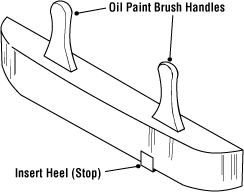Woodworking Machines - Push Sticks
On this page
When should you use push sticks?
Back to topPush sticks or push blocks should be used when operating standard woodworking machinery, including table saws, band saws, radial arm saws, jointers, planers and shapers. These sticks protect the hand while allowing good hand control of the stock as it is pushed through the cutting head or blade. Push blocks for jointers or planers should be constructed for two-handed positioning.
To keep your hands away from the blade:
- Always use a push stick for pieces less than 30 cm (1 ft) in length or for the last 30 cm of a longer cut.
- Use a push stick of appropriate length to ensure your hand is away from the blade. For example, if you need to cut wood within 30 cm of the blade, use a push stick that is at least 45 cm long.
- Use the push stick to remove the cut piece from between the fence and the blade.
What are some features of a push block?
Back to topHold-down push blocks should:
- be rigid
- enable the operator to protect both hands
- allow the operator to exert a firm and steady pressure on the work piece.
The following are samples of push blocks.
Simple push sticks are useful on a table saw when the distance between the blade and fence is narrow.

A simple push stick is useful on the table saw when the distance between the blade and fence is narrow.

Double-handled hold-down push block

Frontal Push Block

Side Push Block

Use of two push blocks on a single application
- Fact sheet confirmed current: 2024-12-17
- Fact sheet last revised: 2018-04-04

